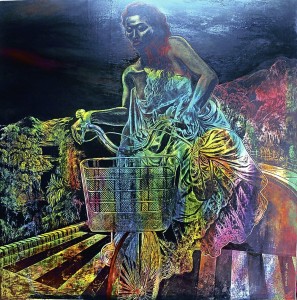
Epiphany, Ascribed to the Greek word epiphaneia, meaning “appearance” or “manifestation,” is the unexpected enlightenment engendered by the sight of an object, or an encounter with another person, or arrival at a familiar place.
It is the poetics that drives the first solo exhibition of serial competition winner Jericho Vamenta, on view at Altro Mondo Arte Contemporanea.
Thus titled “Everyday Epiphanies”—the conjunction of the two words is itself unexpected—the works give rise to an exhilaration of meanings known only to each particular viewer.
What Vamenta aspires for is the transformation of an ordinary situation into a human drama that breathes as naturally real but is experienced as an imagined reality: Did it actually happen? Was it an imagined occurrence? How has the commonplace liberated the person from the bondage of domestic ennui?
One realizes the potentiality of each person to construct his own paradigm of living.
The very titles which Vamenta has imposed on his works are illustrative of a mind that sees meaning and substance in ordinary situations and the performance of daily habits.
The dour simplicity of a word such as “Bike,” so stripped of any lyricism or poetry, leaves the viewer unprepared for the sight of the work at hand: a spectral vision of a woman, Botticelli-like, not, however, emerging from a half-shell, but astride a common bicycle, all flouncing skirt hiked up, like the luscious drapery folds of a Renaissance painting.
Lending a magical, easily haunting emotional fervor to the work is Vamenta’s skill with color: various shades of darkness and radiance achieving a state of immanence, an optical sensation that chromatically blends imperceptibly as though the artist plotted out the areas where a transparency of light is seamlessly aligned to the woman’s interior life.
An uncanny Old World quality radiates from what are presumably native scenes.
Dreamlike state
These attributes and skills are lavishly manifest in a work such as “Three Ladies.” Conceived along the classical concept of the Three Graces, the image is over-the-top, the full throttle of an operatic scene where, gathered around an ornately laden table, are three women dressed to the nines, in a furiously elegant armament of costumes.
The gestures and poses are precisely arranged, like Grecian sculptural maidens, stolid in their marble stance. And yet the wonder lies in the dreamlike state of the human figures.
To this we can only ascribe to Vamenta’s effective use of—in principle at least—the drypoint, a printmaking technique of the intaglio family, in which an image is incised into a plate with a hard-pointed “needle” of sharp metal.
The artist himself describes his working method:
“The work is executed with oil and oil pastel on marine board. The board is coated with primer and several layers of plaster. Filled and rendered with oil colors and pastels from light to dark tones. A top coat of oil in dark hues is painted over and over layering pastels. I used an industrial nail to scratch the surface. It is sprayed with fixative to protect the work.”
All this, of course, would be self-defeating were the artist not adept at draftsmanship. Fortunately, Vamenta is sensitive to the rhythm of lines, distilled to a linear pliancy uncompromised by the need to enhance the volume of his human figures.
Satori in the kitchen
A work like “Catch,” ostensibly a fishing scene, is actually an efflorescence of forms, with the figure of the fisherman rendered stroboscopically, the visage rendered in a succession of movements.
The woman emerging from the fishnet, like a fish surging up for its first ecstatic inhalation of air, remains anchored to the net, her feet transformed into a tangle of roots.
In “Fish,” domestic domain is the spatial preoccupation of Vamenta.
He, however, invests the dismal scene with ceremonial pomp and the pageantry of pots and pans. Think of it as satori in the kitchen sink.
Is Jericho Vamenta The Next Big Thing? Already the artist has chalked up an impressive litany of awards: Grand Prize winner (Oil Painting category) at the 2011 Metrobank Art and Design Excellence competition; and Grand Prize winner in the 2012 Philippine Art Awards.
Collectors and investors have been so avid in discovering who the next darling of the auction houses will be. Vamenta’s show may yet be their own epiphany.